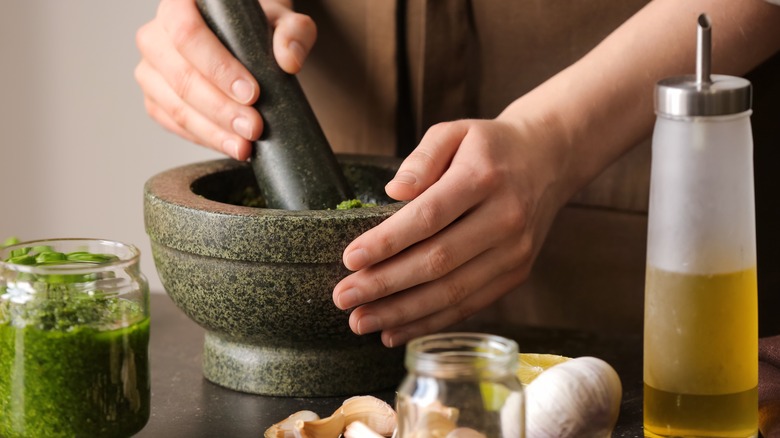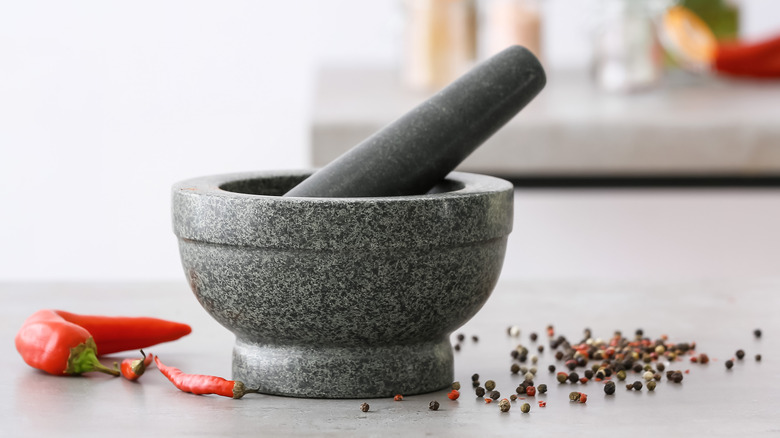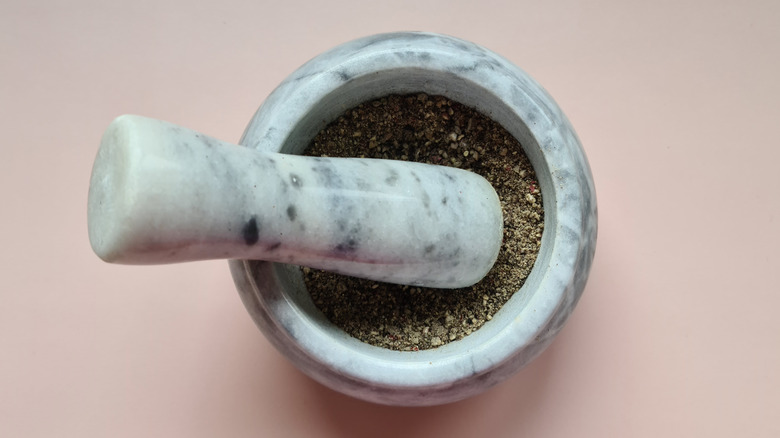The First Thing You Need To Do With A New Mortar And Pestle
In a modern kitchen full of immersion circulators, vacuum sealers, and induction cooktops, a primitive mortar and pestle still matters. This bowl paired with a tool for mashing is 10,000 years old. As technology advances, mortars have been made out of many materials, but there's nothing wrong with versions close to the original. For example, stone molacajetes made from lava-born basalt are still a mainstay in Central America and kitchenware stores everywhere.
Pulverizing food can be done in all manner of appliances, but a mortar and pestle is arguably still the best way to grind spices and make storied recipes like guacamole, salsa, and aioli. The traditional method of making pesto is the perfect example of how this simple tool can elevate a simple dish. A mortar and pestle connects the cook more closely to the food, but there's more to it than that. The pounding of a pestle is actually gentler than the whirring blades of an electric appliance. Food that's cut — and re-cut — in a blender or food processor becomes warm, and flavors can be muddied. The emulsion that slowly builds by crushing in a mortar is creamy yet light, and every delicate flavor is preserved. It pays to make your own pesto, especially if it's done in a mortar and pestle.
How to season a new mortar and pestle
Certain tasks can be done in small, ceramic mortar and pestles, but the most useful versions are typically the heavy, granite versions, like the one favored by USA Today. They're more affordable than other materials but perform just as well. The heft of a granite version keeps it stable while pounding. While it's a lot to lug in and out of the cupboard, they are attractive enough to stay on the countertop. You'll use it more often than you think.
A brand new mortar and pestle needs a bit of work before you start smashing some peppercorns, though. Why? The rough surface that's perfect for pulverizing might be ground into the food. To prevent that, MasterClass recommends a thorough rinse with warm water. There's no need for soap at this point; just get rid of loose particles.
Then, add enough white rice to cover the bottom of the mortar with a splash of water. As you start grinding this mixture, you'll be able to see the loose particles in the rice. Don't rush, give this at least five minutes. Remove the rice paste, rinse with warm water, and start over. It may take two to three rounds before the ground rice is perfectly clean, without any particles from the mortar or pestle. Give it a final rinse and allow it to air dry on a rack.
How to clean and maintain a mortar and pestle
Once completely dry, your mortar and pestle is ready to use. This could be a great time to discover a proper aioli. It's not the garlic-flavored mayonnaise that's become so familiar, but rather a ton of raw garlic that's smashed in the mortar and emulsified with lots of oil.
And to keep that batch of aioli from tainting some ground cardamom pods the next day, there is a best way to clean the mortar and pestle, and it includes soap. Many believe soap will be absorbed into the mortar and lend that flavor to the next recipe. America's Test Kitchen put that to the test and never noticed a transfer of soapy flavors.
So, to clean a mortar and pestle, use warm water, a small amount of dish soap, and a brush to remove any residue and lingering odors. As with any kitchen tool, it's best to clean a mortar and pestle before the food has had a chance to dry onto the surface. Be sure to dry the mortar and pestle completely. Standing water can cause them to crack. One of the best parts of a mortar and pestle might be just how easy they are to clean. It sure beats washing a food processor bowl, blade, and lids.


